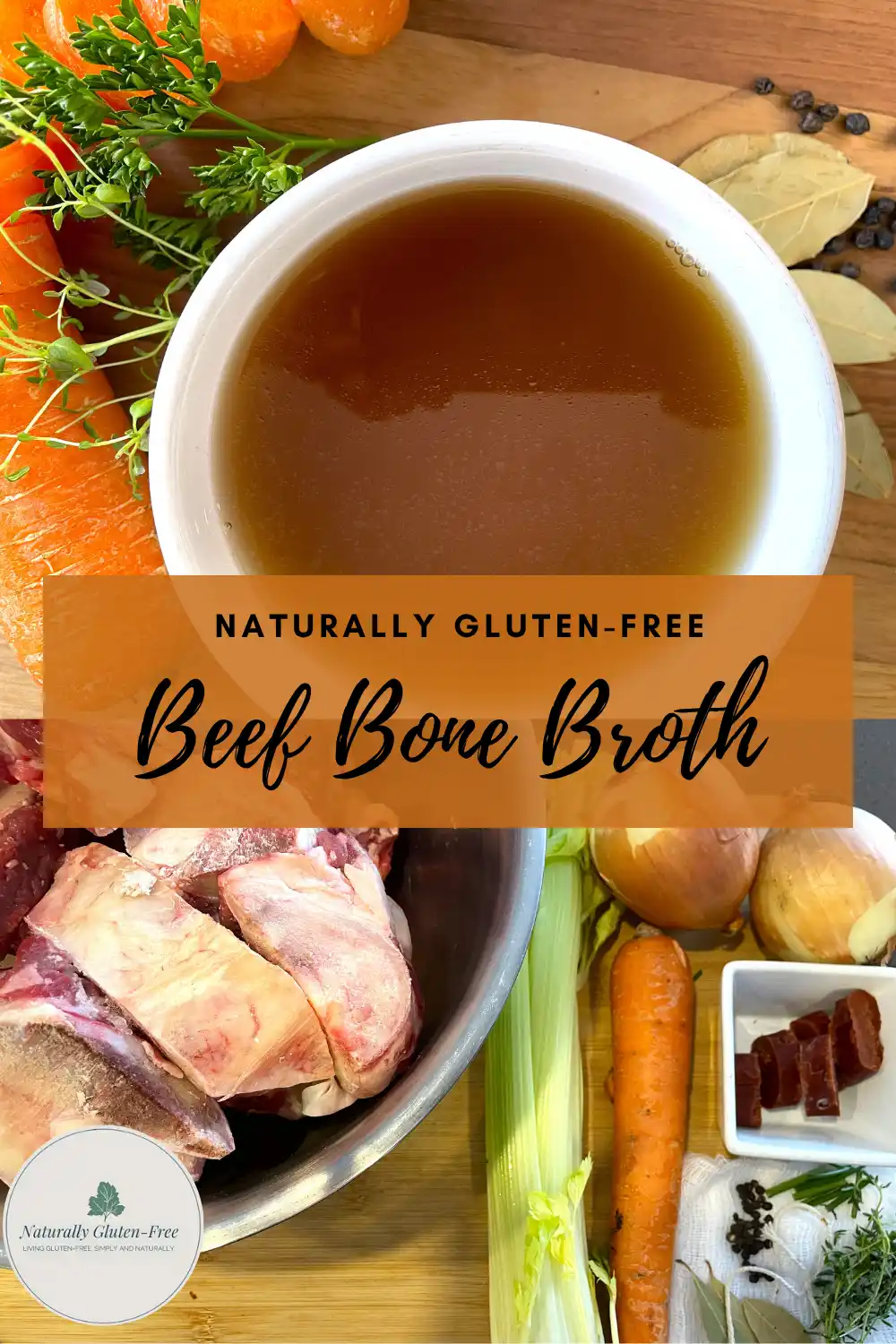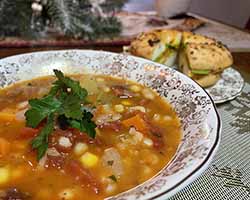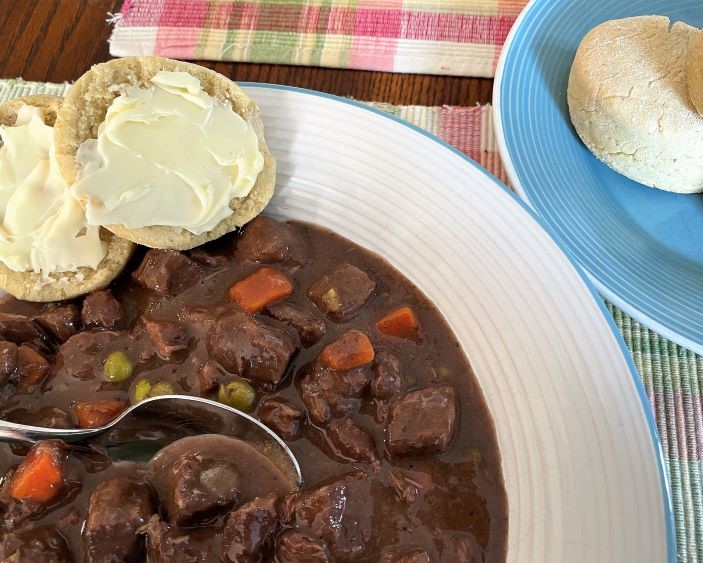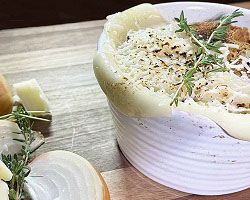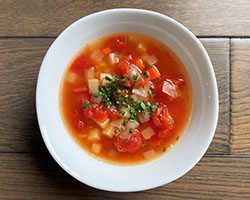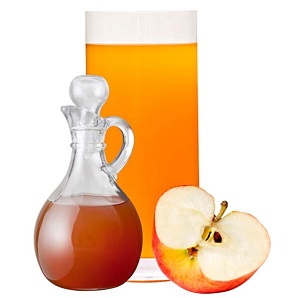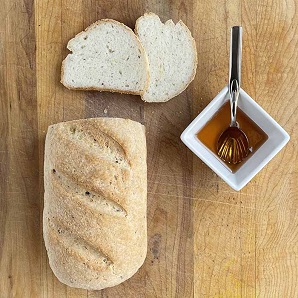- Home
- Gluten Free Cooking
- Beef Bone Broth
Beef Bone Broth Recipe – Safe for Celiacs and Naturally Gluten-Free
What’s all the hype about bone broth?
If you read health news you’ve heard about bone broth and how it can cure everything from leaky gut to joint pain. It makes pretty great soups and sauces too!
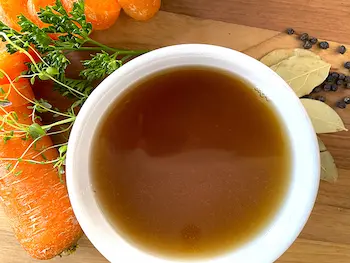
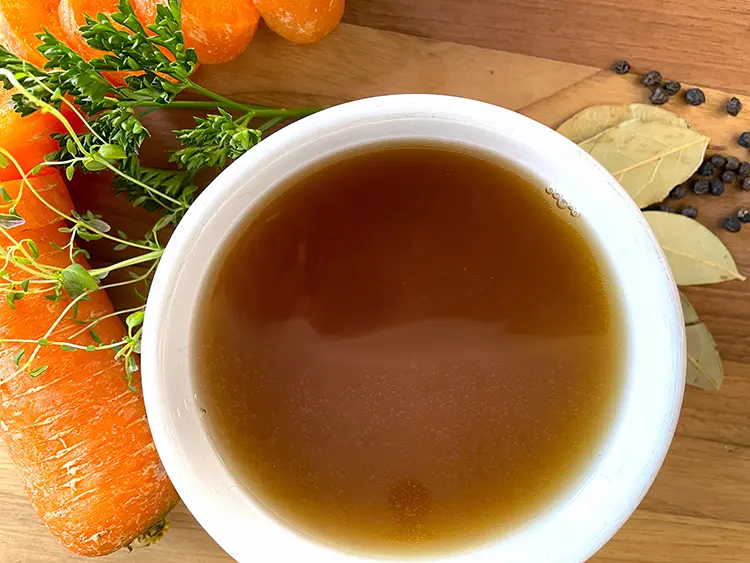
In this guide, I'll get into the benefits of bone broth, but more importantly, I’ll share my personal beef bone broth recipe.
Soon you'll be making the best beef bone broth you’ve ever tasted.
And guess what, it’s naturally gluten-free!
Table of Contents:
Jump to the section that interests you most or scroll through for all the info.
Is Beef Bone Broth Gluten-Free?
Most homemade bone broth recipes are gluten-free. The ingredients are simple: beef bones, vegetables, aromatics, herbs and water.
Be careful if you’re buying prepared broths. Many are gluten-free, but some contain yeast extract which can come from barley.
Canadian labels must list barley if used, but not in the U.S. – so look for a gluten-free claim on the label.
Also be wary of beef bouillon as many brands contain gluten. Knorr Beef Oxo Cubes for example contain wheat, yet Knorr Beef Bouillon Cubes are gluten-free. Always check labels.
Broth or Stock – What’s the Difference
While these two terms are often used interchangeably, there is a difference.
Stock is made from bones, broth from meat. Bone broth is essentially a rich, long-simmered stock.
Benefits of Beef Bone Broth
Bone broth, although ancient in origin, has recently gained popularity as a health superfood. According to various sources, bone broth may:
- Improve skin, hair and nails
- Reduce inflammation
- Improve gut health
- Reduce joint pain and stiffness
- Support weight loss
- Aid in muscle growth and recovery
Some of these are symptoms we celiacs struggle with even after going gluten-free.
But, how could a modest broth have so many benefits? It’s the nutritional profile. Beef bone broth is rich in collagen, certain amino acids as well as vitamins and minerals1.
But does it stand up to the claims?
There have been some animal studies, and human studies are underway, so the evidence is pointing in a positive direction. Still we’re not quite there yet when it comes to proof2.
My position is this: it's nutritious, delicious, and made from naturally gluten-free ingredients, so it's a yes for me. I'll watch the science with interest, but I see no down side.
Benefits of Making Your Own Homemade Beef Bone Broth
Making homemade stock can have several advantages:
- You control the ingredients so you know it’s gluten-free.
- It has no preservatives, emulsifiers or sugars like many commercial brands.
- It's real, whole food.
- It costs less than ready made products.
Equipment You'll Need – Shop the Guide
Here's what you’ll need to make this recipe.
For your convenience, I’ve sourced some items for you. If you decide to purchase from these links, I may make a small commission at no extra cost to you.
- A large stock pot (at least 8-quart capacity)
- A 6" square of cheesecloth and 8* string for the spice bag
- More cheesecloth for straining
About the Ingredients
Beef Bones: What to Buy and Where to Get Them
Your local butcher is the best source for beef bones. You may want to call ahead to give them time to make up your order.
A variety of cuts including beef shanks, neck bones, ribs, and knuckle bones will add complexity and richness.
Bones with meat left on them will help enhance the flavor and the nutritional profile of your broth.
Ask your butcher to cut large bones to about fist size—they’ll extract flavor better and fit your pot.
What is a Spice Bag and Why Use it
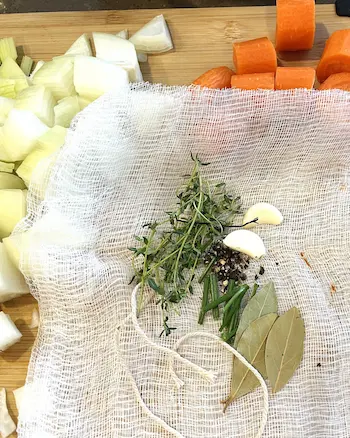
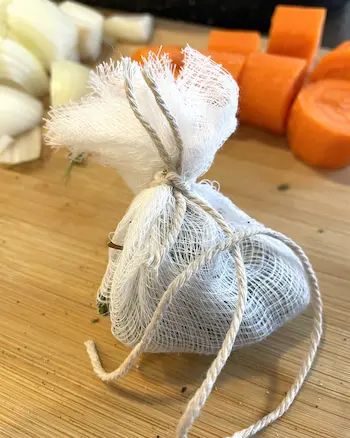
A spice bag is a piece of cheesecloth tied up with a string that contains herbs and spices. The bag makes them easy to remove. This is important for soups, but less so stocks and broths since you will be straining the liquid.
Why Add Vegetables to Beef Bone Broth
Vegetables add flavor and nutrients to your broth and are a good way reduce waste. Your great-grandmother likely had a stock pot simmering on the wood stove and tossed in all sorts of vegetable trimmings.
Classic aromatics like onion, carrot, and celery add depth and nutrition.
Avoid starchy or strong-tasting veggies like potato, broccoli or cabbage. They will color the stock and affect the flavor.
Why Brown Your Beef Bones
Roasting bones with tomato paste develops deep, rich flavor—it's an essential step so don’t skip it.
Do’s and Don’ts for Making Your Beef Bone Broth the Best it Can Be
Important Do's:
- Roast your bones with tomato paste for deeper flavor
- Simmer for 8–10 hours
- Skim to remove foam and fat
- Maintain a gentle simmer, not a boil
Important Don'ts:
- Don't stir the stock
- Don't let it boil
- Don't cover the pot
- Don't add salt during cooking
Understanding the science behind stock making will help explain why these do’s and don’ts are so important.
Stirring, Simmering and Skimming
As the water starts to simmer, impurities will be released from the bones. Most will remain stuck to the bones and some will rise to the top in the form of foam. This why you don’t stir your bone broth and why you don’t want a rolling boil. If these impurities get mixed though the water they will affect the flavor of your broth.
Simmer gently, skim what you can off the top and leave the rest stuck to the bones to be strained out at the end.
Skim your stock again right at the end to get as much of the fat off the top as you can.
Lid or No Lid
Many recipes will tell you to put the lid on the pot. Chefs do not use lids on their stock pots and here’s why.
The flavor develops through two main processes:
- Infusion - where flavors from the ingredients slowly seep into the water.
- Reduction - where water evaporates, concentrating the flavors.
A lid traps steam, diluting your broth and sacrificing flavor.
Why Leave Out the Salt?
Stocks are a base for other dishes like soups and stews or cooking liquid for rice and other grains. It’s best to season those dishes as you make them. If you are drinking your broth from a cup, add a little salt when you reheat it.
How to Tell a Good Quality Bone Broth
It’s in the gelatin!
A good broth will gel when cold—that means it’s rich in collagen. It also adds luxurious mouthfeel to soups, gravies, and sauces.
Uses for Bone Broth (or Stock)
You can use gluten free beef broth in many ways:
- As a base for soups and stews
- For braising meats
- As a warming, nutritious beverage
- To cook gluten-free grains
- As a base for gravies and sauces
Beef Bone Broth as Part of a Clear Fluid Diet
If you're on a clear fluid diet for a medical procedure, or during a fast or illness, consider including bone broth. It’s nutritious and soothing, especially for an upset tummy.
Don’t do a clear fluid diet for more than a day or two without medical supervision3.
How to Store Your Gluten-Free Beef Bone Broth

Proper storage is crucial. Your broth will keep for:
- 5-7 days in the refrigerator
- Up to 6 months in the freezer
I like to freeze my broth in 2 cups freezer bags. I lay them down flat on a tray. Once frozen they stack neatly and don’t take up much space.
If you freeze your broth in containers leave some head space for it to expand.
The Recipe

Beef Bone Broth Recipe – Safe for Celiacs and Naturally Gluten-Free
By Patty Maguire – Naturally Gluten Free,

Make rich, nourishing beef bone broth at home—naturally gluten-free and perfect for anyone with celiac disease or gluten intolerance.
Prep Time: 10 minutes
Cook time: 10 Hours
Yield: 9 to 12 servings
Tags: Gluten Free,
Ingredients
- 8 pounds of beef bones with meat attached
- 8 ounces of onion, coarsely chopped
- 4 ounces each of carrots and celery coarsely chopped
- 2 tablespoons of tomato paste
- Herbs for the spice bag (thyme, crushed peppercorns, parsley stems, bay leaf)
- Optional: 2 or 3 whole garlic cloves
Instructions
- Preheat your oven to 375°F. Put a little oil in the bottom of a roast pan. Roast the bones for about an hour. About 15 minutes before they are done, add tomato paste to the bones, stir and finish roasting until everything is a rich mahogany color.
- While the bones are roasting, chop up the vegetables and prepare the spice bag. Because the veggies will be cooking for a long time you can cut them into fairly large pieces.
- Place the bones and vegetables in the stock pot and add about 6 quarts (or 6 liters) of cold water. Add the spice bag and tie the end of the string to the handle of the pot so you can remove it if you need to.
- Deglaze the pan you roasted the bones in by adding a little water, heating on the stove top and stirring all the nice brown bits up off the bottom of the pan. Add the brown liquid to the stock pot. Skip this step if anything in the pan is burnt. You don’t want that burnt flavor in your stock.
- Bring the water slowly to a gentle simmer; you don’t want a rapid boil. As the stock begins to simmer some foam and sludge will make its way to the top. Keep skimming this off with the ladle.
- Let the stock simmer, skimming occasionally if needed, until done.
- Strain your stock through a fine strainer lined with cheesecloth into a large bowl or container. Cool in an ice bath or in the refrigerator.
- Store as directed or use immediately.
Frequently Asked Questions about Beef Bone Broth
Q: How do I know when my broth is done?
A: The liquid will be rich in color and flavor, and reduced by about 1/3 from the original volume. About 10 hours of simmering will give you this result.
Q: Can I make beef bone broth in a slow cooker?
A: You can, but you’ll need to make a smaller batch and use the lid. I prefer the stove top method, but if you decide to try the slow cooker, roast the bones first and cook on low for 24-48 hours.
Q: How can I tell if my broth is rich enough?
A: When cooled, it should have a jelly-like consistency due to the gelatin content.
Q: Can I reuse the bones?
A: It’s not recommended as most of the flavor and nutrients will be gone and the second batch will be much weaker.
Q: What are the best commercial brands for gluten-free beef broth?
A: Popular gluten-free U.S. brands are: Kettle & Fire, Bonafide Provisions, and Pacific Foods. In Canada look for Campbells or Kitchen Basics. Always check labels.
Q: What should I not put in my beef bone broth?
A: Leave out starchy vegetables like potatoes and strong tasting vegetables like cabbage or broccoli.
Q: What are the best bones to use for beef bone broth?
A variety of bones like beef shanks, neck bones, ribs, and knuckle bones will add complexity and richness. Bones with meat left on them will help enhance the flavor and the nutritional profile of your broth.
Recipes Using Beef Broth
Sources
1. MediLexicon International. (n.d.). The top 6 bone broth benefits. Medical News Today. https://www.medicalnewstoday.com/articles/323903#summary
2. LM;, A. R. G. (n.d.). Bone broth unlikely to provide reliable concentrations of collagen precursors compared with supplemental sources of collagen used in collagen research. International journal of sport nutrition and exercise metabolism. https://pubmed.ncbi.nlm.nih.gov/29893587/
3. professional, C. C. medical. (2025, April 26). Clear liquid diet: Description, how to follow and using for colonoscopy, diverticulitis. Cleveland Clinic. https://my.clevelandclinic.org/health/treatments/21764-clear-liquid-diet
